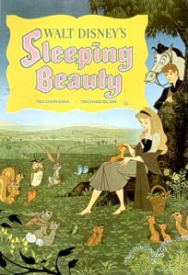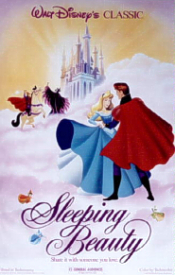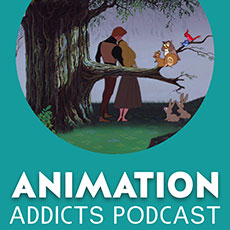Walt Disney Home Video (1959), CAV/CLV, 2 discs/3 sides plus supplements, 75 mins, 2.35:1 letterboxed widescreen, Dolby Digital 5.1 Surround, Rated G
 When Sleeping Beauty finally made its 2-disc DVD debut in 2003, a wider audience was at last given a chance to see the film shine in its original 2.35:1 aspect ratio, which was cleaned up beautifully for its anniversary edition LaserDisc box set. Disney kept up their tradition of porting much of the material from the LD sets over to the DVD edition, and there was a great deal in store for DVD fans, though for long-time collectors who already had the deluxe LD set it was a case of severe déjà vu…
When Sleeping Beauty finally made its 2-disc DVD debut in 2003, a wider audience was at last given a chance to see the film shine in its original 2.35:1 aspect ratio, which was cleaned up beautifully for its anniversary edition LaserDisc box set. Disney kept up their tradition of porting much of the material from the LD sets over to the DVD edition, and there was a great deal in store for DVD fans, though for long-time collectors who already had the deluxe LD set it was a case of severe déjà vu…
Sleeping Beauty, the box set, came right at the end of the Disney SE boon for laser animation fans. Although several more releases would feature limited extras, Sleeping Beauty went all out, including an entire bonus disc dedicated to the supplemental material. The film itself, presented in an absolutely glowing new THX-approved transfer (with 5.1 Dolby Digital), is shown in its original aspect ratio of 2.35:1. The film was the first animated picture to be shot straight to 70mm widescreen (Lady And The Tramp had been 2.35:1 in 1955, but was shot to anamorphic CinemaScope rather than the higher resolution 70mm), and this is what probably dampens some of the energy of the movie.
Sleeping Beauty was not a big hit in its day, and led to the cuts in animation budgets that would bring in the “sketchier” Xerox look of the 1960s, as well as a turn towards more contemporary fare instead of the fairy-tales of old. The stylised art does include a great attention to detail, but the rather vertical angular design does not sit pretty with the horizontal widescreen approach, and the characters often leave much of the frame bare. Having said that, seeing the film in widescreen again (after the much maligned pan-and-scan VHS issues) does make one appreciate the work gone into what is generally looked on as the last of the true “golden age” animated features.
Running at only 75 minutes, the movie is spread over three CAV sides, allowing for full analytical slo-mo viewing of the animation, while the audio mix showcases the original Tchaikovsky-adapted Oscar-nominated score. On side four, the bonus material (in CLV) begins, first with the original live action short that accompanied Sleeping Beauty in its theatrical release. Based on the “Grand Canyon Suite” by Ferde Grofé, Grand Canyon is also presented in 2.35:1 widescreen with its original six-track musical score preserved in 5.1 Dolby Digital sound. Running a good-half hour, the film basically presents amazing images from the Grand Canyon itself, synchronised through on-camera movement and editing to the music. More akin to Disney’s own True Life Adventures, the film is not the most exciting of productions, although the cinematography is astounding, and the film went on to win the Academy Award for Best Live-Action Short of 1959.
 Broadcast on the DisneyLand TV show on the day of Sleeping Beauty’s release, The Peter Tchaikovsky Story was a large segment of an episode that looked at the making of the Sleeping Beauty film. The Tchaikovsky segment (the link being that the music to the film was adapted from his original music for the Sleeping Beauty ballet) was later re-packaged as a theatrical short for international release, and this is the version on offer here. Presented in its original full-frame 1.33:1, the half-hour featurette is a very tightly paced film, showing that the Studio was just as adept at quality live-action filmmaking as well as animation. In fact, with some room to breathe and missing the narration needed to rush the story from sequence to sequence, The Peter Tchaikovsky Story would have made a very engrossing live-action feature in its own right.
Broadcast on the DisneyLand TV show on the day of Sleeping Beauty’s release, The Peter Tchaikovsky Story was a large segment of an episode that looked at the making of the Sleeping Beauty film. The Tchaikovsky segment (the link being that the music to the film was adapted from his original music for the Sleeping Beauty ballet) was later re-packaged as a theatrical short for international release, and this is the version on offer here. Presented in its original full-frame 1.33:1, the half-hour featurette is a very tightly paced film, showing that the Studio was just as adept at quality live-action filmmaking as well as animation. In fact, with some room to breathe and missing the narration needed to rush the story from sequence to sequence, The Peter Tchaikovsky Story would have made a very engrossing live-action feature in its own right.
On the third disc, in its own sleeve, we find the bulk of the supplementary material. Once Upon A Dream: The Making Of Sleeping Beauty features new and archival footage with cast and crew, among which is one of the last interviews with animator Marc Davis. Running a good 15 minutes, the documentary provides a great deal of information, as well as some insights from the next generation of Disney artists on how the film has influenced them (Eric Goldberg, for instance, cites it as an important element in the production design for Pocahontas). Concept Art runs like a mini-extension to the documentary, with designer Eyvind Earle explaining his approach to the look of Sleeping Beauty, and more comments from Goldberg and Pocahontas co-director Mike Gabriel. The LD “step” function is then utilized to view an extensive collection of sketch and finished concepts, which really do show their inspiration in both Pocahontas and Beauty And The Beast.
An entirely separate look at the Character Design for Sleeping Beauty features individual sections on all the main and supporting characters, from Briar Rose/Princess Aurora, Maleficent and her Minions, Flora, Fauna and Merryweather, The Royal Households, as well as Miscellaneous Characters. There is more concept art on show in the Miscellaneous Storyboards section, as well as a look at two extremely detailed storyboard sequences, The Fairies Put The Castle To Sleep, and The Capture Of The Prince. Layouts And Backgrounds offers more concept and layout art, showing various scenes in their initial design stages. Designer Earle returns to describe how a background would be created, in a short clip that features new interview and archival footage. A selection of Miscellaneous Backgrounds then allows us to step through a series of completed images, some with their final character composites included! The Sleeping Beauty Storybook closes the art sections by showing the separate pages of the prop “storybook” that opens and closes the movie in a wonderful full-frame presentation. This really does show the effort and time that went into this lavish and detailed film, right down to some unseen pages, and others glimpsed at for only a few frames in the final production.
Next up are some more video clips (these seem to run as an extension from the main documentary and provide a nice way to break up all the still images). Live Action Reference is a clip from the beginning of production, which originally aired on the DisneyLand TV show in 1954, featuring live-action model Helene Stanley as Aurora (she also did the honours for Cinderella) in full costume, dancing about for the reference benefit of animators Marc Davis and Frank Thomas, among others. A second clip shows the only surviving live-action footage filmed specifically for the movie, featuring the Prince’s fight with the Maleficent Dragon, and some interaction between the Queen and one of the three fairies (delicately portrayed here by a man)!
The Music Of Sleeping Beauty is exactly what it sounds like – a video clip on the use of Tchaikovsky’s ballet as the film’s musical soundtrack, with Mary Costa (Aurora) describing her feelings in working on the film and performing along to Tchaikovsky’s music. Finally on this side, a Widescreen To Pan-And-Scan Comparison is exactly the kind of clip that the current crop of marketing people at Disney should take a look at. Presenting the entire Once Upon A Dream sequence in a spilt screen between the 2.35:1 image and the cropped full-screen 1.33:1 ratio beneath shows the dramatic loss of picture in the original video transfer. The actual clip was perhaps not the best to illustrate this though, as only rarely do the characters escape either left or right of frame. It’s the background and general framing that benefits from the wider ratio, but the clip is an important little addition that shows just how much would have been lost had Sleeping Beauty’s transfer to disc been compromised.
 Side six features another selection of bonus materials, including some still galleries of the various Print and Publicity campaigns. Sleeping Beauty has been issued several times since 1959, and this section features posters from the original release, re-issues in 1970, ’79 and 1986, as well as a gorgeous poster for the 1996 international re-release. The Theatrical Trailers section that follows features both a 1959 teaser (in original full-frame) and theatrical release trailer (widescreen), as well as the 1995 international re-issue trailer (in 1.85:1 letterbox) that is one of the best re-release trailers I have ever seen. Drawing on the impish and playful nature of the film, this trailer, with its use of Danny Elfman’s BeetleJuice underscore, really dresses the movie up as a major animation event, almost pushing it as a new film! It’s one of those clips that one could watch again and again, delightfully composed and edited with a great sense of respect for the original, but playing to a whole new audience – fantastic!
Side six features another selection of bonus materials, including some still galleries of the various Print and Publicity campaigns. Sleeping Beauty has been issued several times since 1959, and this section features posters from the original release, re-issues in 1970, ’79 and 1986, as well as a gorgeous poster for the 1996 international re-release. The Theatrical Trailers section that follows features both a 1959 teaser (in original full-frame) and theatrical release trailer (widescreen), as well as the 1995 international re-issue trailer (in 1.85:1 letterbox) that is one of the best re-release trailers I have ever seen. Drawing on the impish and playful nature of the film, this trailer, with its use of Danny Elfman’s BeetleJuice underscore, really dresses the movie up as a major animation event, almost pushing it as a new film! It’s one of those clips that one could watch again and again, delightfully composed and edited with a great sense of respect for the original, but playing to a whole new audience – fantastic!
A look at The Restoration Of Sleeping Beauty follows, and this has to be seen to be believed. Every one of the 10,800,320 frames of the film were individually scanned into the computers at Disney, after which each character was rotoscoped and removed from the scene. The background “dust busters” would then go to work, removing cell dirt, scuff and film scratches from the images. Clean-up artists would work on the characters, removing blemishes and almost “re-painting” the entire film frame-by-frame using the original color palette to perfectly match the original coloring. These separate layers were then recomposited and scanned back out to a new film negative for theatrical exhibition. The digital files were used for this conversion to LaserDisc and the eventual DVD, helping Aurora look more beautiful than ever!
During production, in January 1956, Helene Stanley appeared on the Mickey Mouse Club TV series, on “Guest Start Day”. This full sequence is shown in the next video clip, with Helene interacting with the Mouseketeers in a re-enactment of the Once Upon A Dream sequence. She’s all dressed up in Aurora’s Briar Rose outfit, and picks one of the kids to be her Prince Charming, and this would have been awesome to see as a child back in 1956 – a full three years before the film was due to hit theaters! Apart from the novelty value in a clip like this, of most interest to fans will be the original piano demo version of the song that plays during the cast’s “ballet” interpretation of the music.
This LD edition of Sleeping Beauty’s supplemental features ends with Four Artists Paint One Tree, a Technicolor short from the DisneyLand show An Adventure In Art, from 1958. In this film, narrated by Walt himself and using score from the still-to-be-completed Sleeping Beauty, we find artists Marc Davis, Eyvind Earle, Josh Meador and Walt Peregoy on a trip in the woods to see the individual approaches they take in painting the same tree. The 15-minute short is a fascinating look at the varying styles each artist feels comfortable with, and the different ways four people can see the same object. Directly tied to the making of Sleeping Beauty, this film was made during its production and features a few clips and comparisons to the background style as seen in the final film, and was a natural and welcome inclusion on the DVD edition. It also reveals the amazing and somewhat unbelievable way that the effects artists achieved Flora, Fauna and Merryweather’s sparkling fairy-dust – amazing!
 Packaging-wise, the Sleeping Beauty: CAV Widescreen Edition does not come with any of the kind of non-disc extras that had been included in previous sets (such as the lithographs in The Lion King, the wonderful hardcover book in Snow White, or the remastered CD soundtrack with Pinocchio). As with The Hunchback Of Notre Dame set, things are limited to just the actual discs. They come housed in their own sleeves, with the main feature presented in a very nice gatefold jacket that contains some additional image material, as well as a brief “overview” text essay on the production and release of Sleeping Beauty.
Packaging-wise, the Sleeping Beauty: CAV Widescreen Edition does not come with any of the kind of non-disc extras that had been included in previous sets (such as the lithographs in The Lion King, the wonderful hardcover book in Snow White, or the remastered CD soundtrack with Pinocchio). As with The Hunchback Of Notre Dame set, things are limited to just the actual discs. They come housed in their own sleeves, with the main feature presented in a very nice gatefold jacket that contains some additional image material, as well as a brief “overview” text essay on the production and release of Sleeping Beauty.
The LD rounds itself up with a list of credits, revealing that the “TV Is OK” team of Kurtti/Pellerin was behind this release, a pair well known to Disney supplement fans, and who still collaborate with Disney on such collectors titles as the Walt Disney Treasures DVDs. Pretty much all of this content did make it to the DVD, which added to the experience with a new commentary track hosted by Kurtti and combining archive remarks from the animators and a 3D representation of the stills galleries as well as a couple of new set-top games. It’s a (just about) worthy upgrade, but for those with their LD boxes now, this Sleeping Beauty set really is worth revisiting!





